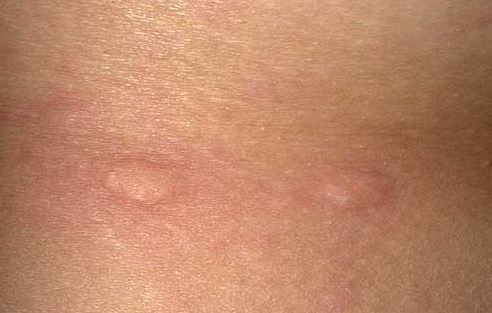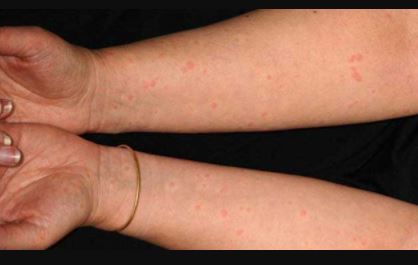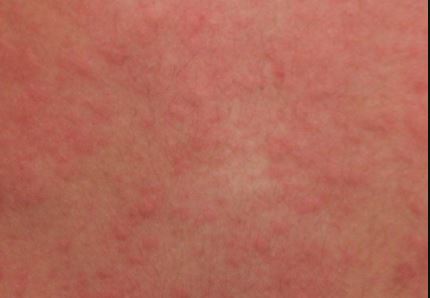Cholinergic Urticaria
What Is Cholinergic Urticaria?
Cholinergic Urticaria is labeled because sweat glands are innervated by cholinergic nerve fibers and “urticaria” means rash. Cholinergic Urticaria or commonly known as “hives”, appears as itchy rashes that affect any part of the skin. This condition is a heterogeneous group of diseases with many subtypes.
Mostly, all the types of urticaria present have a common and distinctive clinical manifestation pattern such as the progression of itchy weal (small raised areas develop on the skin) and flare type skin lesions (angioedema).
For each wheal it looks like mild blisters and it feels as a sensing intense itchiness, it also appears to be surrounded by a small read area of the skin called flare. In addition, the weal is usually 1-2 cm in any shape but commonly appear to be in round.
The appearance of the weal can fade as the allergic reaction subsides but the surrounding flare remains for a while thus make the skin look blotchy and red. However, these blotches may fade gradually and the skin will return to its normal condition. ![]()
In many cases the Cholinergic Urticaria occurs in both sexes. However, according to Dermnetnz.Org, the condition often occurs in males than females. And usually appears in people aged between 10 and 30 years and persists for several numbers of years before it become less chronic.

Causes
The cause of the cholinergic urticaria is due to the cells that have been trigger to release chemical such as the histamines. These chemicals cause the fluid to outflow from the tiny crevices of blood vessels under the skin surface thus this fluid makes to form the weal.
It also causes the blood vessels dilate meaning to open wide causing the flare around the wheals. Some of the following listed items below are the common cases reported that give rise to trigger the cholinergic urticaria;
- Infection as a result of allergic reaction
- Insect bites
- Food allergy
- Psychological stress
- Hot and Cold temperature
- Vibration
- Hay Fever or Asthma
- Autoimmune Problem (our own immune system causes damage to some of our body’s own cells.)
Furthermore, half of the cases of the causes are still remain unknown. Therefore, further studies are needed to determine accurately its specific cause.
Signs and Symptoms
The typical signs and symptoms of Cholinergic Urticaria include;
- Intense Itchiness
- Tingling & burning Sensation
- Onset of number of weal surrounded by bright red flares
- For severe condition, patient may experience systemic symptoms such as headaches, salivation, palpitation, fainting, and shortness of breath, wheezing, abdominal cramps and even diarrhea.
In rare case, patient can also lead to
- Anaphylactic shock
- Anaphylactoid reactions
- Angioedema- it occurs anywhere in the entire body but the most commonly the cholinergic reactions affects the eyelids, lips, and genitals.
- Hepatocellular injury
Pathophysiology
The pathophysiology of cholinergic urticaria are caused by inflammatory of the skin because of the skin lesions causing the leakage of capillaries in the dermis thus results in an edema which persists until the interstitial fluid absorbed into the surrounding cells. The urticaria happens mainly because of the release of histamine and other mediators of inflammation known as cytokines from cells in the skin.
Evaluation & Diagnosis
To accurately determine the exact condition of the patient due to some underlying factors, medical practitioners perform and follow several guidelines in determining the specific disease. In this case patient with cholinergic urticaria will undergo the following;
Physical Examination
Physical Examination accompanied with structured question- Doctors undergoes evaluation by asking the patient in terms of the frequency, timing, and duration of the attacks of cholinergic urticaria. For instance, doctor may ask the patient if him or her experiencing angioedema or wheezing in association with urticaria.
Clinical examination
Followed by Clinical examination such as Skin Pricking test that helps to determine if a particular individual is atopic and if there are specific contact antigens, such as foods or latex which usually also one of the main factor that trigger to cause urticaria.
Challenge testing
Challenge testing is used to determine if patient is developing another type of urticaria such as demographism (a type of urticaria that triggers to become allergic in too much cold or heat, it is also known as cold urticaria). In challenge test, patient is subject to have an applied ice on the forearm for a certain minutes then allowing the skin to rewarm.
Skin biopsy
Sample is taken from a new lesion to further evaluate if urticarial vasculitis is suspected.
Treatment
The mainstay of therapy for both acute and chronic urticaria is primarily the patient education, secondly avoiding some of its possible triggers and thirdly using antihistamines to combat its infection. Below are some possible treatments;
Drug treatments
Antihistamines
The primary defense in treating cholinergic urticarial is the use of a standard dose of histamine. According to S J Deacock on his paper “An approach to the Patient with Urticaria”, the histamines workout in such a way of penetrating the blood-brain barrier to only a slight extent and so cause fewer central nervous system side effects than the older first generation anti-histamines.
Some of the listed histamines that can be purchased over the counter in the local pharmacy;
- Hydroxyzine
- Loratadine (Claritin)
- Cetirizine (Zyrtec)
- Desloratadine (Clarinex)
- Allegra (Fexofenadine)
- Xyzal
- Benadryl
- Pepcid and Ranitidine
- Montelukast
Omalizumab
- Another type of drug treatment for cholinergic urtecaria is by using the new kind of treatment drug (Omalizumab). This type of medication effects by binding to Immunoglobulin E inside of the body. This Immunoglobulin E is accountable for allergic reaction. Thus, this kind of medicine drug inhibit the number of IgE compounds in the body.
Corticosteroids
Are a class of steroids hormones that are produced in the adrenal cortex. It involves in widespread physiological systems response in stress, immune system, inflammation regulation, carbohydrate metabolism and protein catabolism and blood electrolyte levels. The corticosteroids may come in a form of pill, creams, shots and etc. Some of the common corticosteroids are listed to treat cholinergic urticarial.
- Prednisone
- Ciclosporin
General Measures
Avoid the triggering factors and Aggravating factors such as;
- Avoid wearing tight clothing if there is an appearance of weal in any part of the body
- Secure yourself in a cool area, as the hives may tend to flare up in warmer condtions.
- Avoid some alcohol, hot baths and strong sunlight if you feel that these factor triggers the cholinergic urticarial
- Ask and consult yourself to your doctor if you think some medications triggers to cause cholinergic urticarial. Note: Always consult your doctor if the symptoms persists longer.
Images



Sources:
- https://www.ncbi.nlm.nih.gov/pmc/articles/PMC3667285/
- http://emedicine.medscape.com/article/1049978clinical
- https://www.ncbi.nlm.nih.gov/pmc/articles/PMC2492902/
- http://www.aafp.org/afp/2011/0501/p1078.html
- http://www.cholinergicurticaria.net/how-to-treat-cholinergic-urticaria-heat-hives/
- http://www.dermnetnz.org/topics/cholinergic-urticaria/
- http://emedicine.medscape.com/article/1049978-treatment
- http://emedicine.medscape.com/article/1049978-medication#showall

